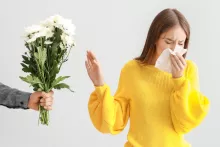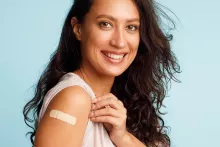Preventing burns during the holidays
The very places you find yourself during the holidays—in the kitchen, around the tree, near the fireplace—are the places most dangerous for severe burns.
By using three basic steps, parents and grandparents can help prevent the tragedy of severe burns for themselves and their families.
-
Know the common-sense rules involving heat and fire.
-
Model those rules yourself and teach them to your family.
-
Be prepared for burns should they happen.
Here are safety rules to follow for each of those areas in your home where burns are most likely to occur.
In the kitchen
-
Any cooking with hot liquids—oils, grease, water, melted sugars and chocolates—must be done with responsible adult supervision.
-
Always have oven mitts out on the counter in plain sight, ready to handle everything from pot lids to cookie trays.
-
Adjust oven racks before you heat the oven, not when they’re heated up to baking temperatures.
-
Clear nearby countertops so you have a flat, temperature-resistant surface to set pots and pans when you move them off the stove or take them out of the oven.
-
Never put out a cooking fire with water. Smother the fire with a pan lid or have a chemical fire extinguisher close by.
-
If something is burning in a pot or pan, don’t try to carry it outside. Trips and spills while transporting burning items result in serious burns for both the carrier and those around them.
-
For pots on a stove, turn handles toward the wall to prevent curious toddlers from reaching up for them.
-
Keep electrical cords for counter-top appliances short by coiling them. Don’t let them dangle where small children can pull them.
-
Don’t carry hot foods or liquids while carrying a child or pet, or while kids and pets are underfoot.
-
Avoid using tablecloths, to keep toddlers from pulling them and bringing hot items down on them.
-
While cooking, wear short or close-fitting sleeves to avoid catching your clothing on fire.
-
Keep your hot water heater set to a temperature low enough to prevent scalding (120 degrees F or less).
-
Keep hot items (hot chocolate, coffee, tea, soup, sauces, and dips) away from the edge of tables or countertops.
-
To safely enjoy coffee, use a travel mug with a tight-fitting lid.
-
Leave dessert pyrotechnics to the professionals. While sparklers, gas torches, or flaming alcohol may provide drama, they also place you and your guests at risk for major burns.
Around the tree
-
If you have a fresh cut tree, be sure its trunk is in water and the water is refilled every day.
-
Use only safety-rated electric lighting for your tree—no lit candles or antique light strings.
-
Circuits get overloaded and create hot wires when too many strings are connected together.
-
Inspect your tree lights for any frayed wires or faulty connectors.
-
Bulbs from older light strings can reach temperatures hot enough to burn fingers and mouths. If you choose to use older lights, place them out of reach of small children.
-
Because lights can build up heat, keep them separated from gift wrappings.
-
If you’re using a fragrance burner to fill your house with holiday aromas, be sure it’s somewhere it won’t be tipped and is out of reach from small children.
-
Locate your tree away from heat sources like radiators, furnace vents, space heaters, and fireplaces.
-
Remove your fresh tree relatively soon after the holidays.
-
Always turn your tree lights off before going to bed or leaving the house.
-
Replace your smoke detector batteries when you’re putting up your holiday decorations.
Near the fireplace
-
Keep fires to a low level. Burning wrapping paper and gift boxes can stoke up a raging blaze and blow hot items back into the room.
-
Never throw propellants—grease, alcohol, other liquid fuels, candles, plastic—into a fireplace or wood stove.
-
Never use gasoline to start a fire.
-
Never burn wood or paper in a fireplace designed for a gas flame only.
-
Invest in a protective screen for your fireplace—including a gas fireplace with a glass cover.
-
Glass doors and panels on woodstoves and fireplaces can become extremely hot (more than 1,000 degrees F). Serious burn injuries from the hot glass can happen in less than a second.
-
Establish a three-foot “no zone” around all hot appliances. Remember that fireplaces and space heaters take time to cool down before they’re safe to the touch.
-
Sleeping on the floor next to a woodstove or fireplace is never a good idea.
-
Keep your cooking to the kitchen. Trying to cook over an open fire in your living room presents too many risks for spills and flare-ups.
-
Have your chimney inspected and cleaned regularly, usually once a year in the fall.
-
On a traditional fireplace, don’t forget to open the damper to keep your home from filling with smoke or dangerous levels of carbon monoxide.
What to do if someone gets burned
Determine the extent of the burn.
-
First degree burns affect the outer layer of the skin. There is pain and redness, like a sunburn.
-
Second degree burns affect deeper layers of the skin. In addition to pain and redness they can exhibit swelling and blistering.
-
Third degree burns damage or destroy the deepest layer of skin including pain receptors, which means there may be more damage than pain levels would indicate. These burns also may appear white and waxy with a dry, leathery texture.
-
Fourth degree burns may involve muscle and bone damage.
You will need to seek medical help for anything beyond minor burns. Burns are an assault on your body’s outer layer of protection, and when that barrier breaks down, bad things can happen.
Emergency medical care for severe burns involves preventing infection, preserving nerve function, and promoting the best means for skin tissue to heal or be replaced.
For a severe burn:
-
Call 911.
-
Keep the victim calm and move them out of danger.
-
Be sure they’re breathing and use CPR if necessary.
-
Loosely cover the burned area with a cool bandage, clean cloth, or plastic wrap.
For a minor burn:
-
Put the skin under cool, but not cold, running water.
-
Cover the area with sterile non-sticky bandage material.
-
Use an over-the-counter pain reliever.

